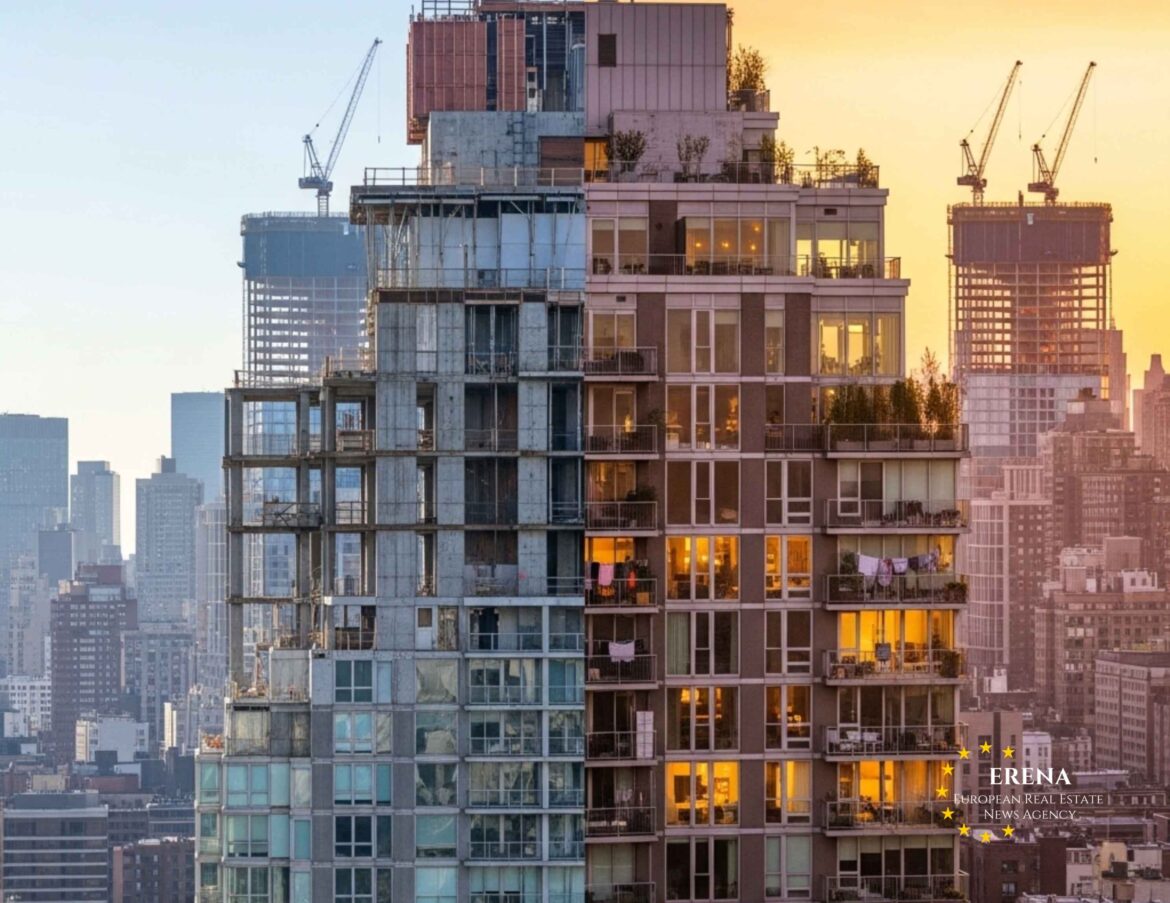In the spring of 2025, New York City completed the largest office-to-residential conversion in U.S. history. A former office building at 25 Water Street in Manhattan’s Financial District was fully transformed into a modern residential complex featuring over 1,300 apartments. The project not only reshaped the landscape of Lower Manhattan but also marked a turning point in the adaptive reuse of commercial real estate amidst changing demand in the post-pandemic era.
From Office Tower to Residential Hub: The Background
Originally built in the mid-20th century, the building at 25 Water Street once housed major corporate tenants. For decades, it served as a typical example of the high-density office culture that defined the Financial District. But the COVID-19 pandemic brought remote work into the mainstream, triggering a sharp drop in office occupancy across New York.
By 2022, vacancy rates in parts of Manhattan had surpassed 20%, prompting both developers and city officials to rethink how underutilized buildings could be repurposed. The result was the SoMA (South Manhattan) project—a large-scale transformation supported by a consortium of developers and endorsed by city planning authorities.
Scale and Scope of the Transformation
The conversion was more than cosmetic. It involved comprehensive reconstruction of the building’s interior systems, structural reinforcement, window expansions for natural light, and the addition of several new rooftop floors. The result: a state-of-the-art residential complex integrating new urban living standards into a once-traditional commercial space.
The total development covers more than 120,000 square meters and includes 1,320 apartments of various types—from compact studios to three-bedroom family units. Importantly, about 25% of the units were allocated as affordable housing, making the project not only innovative but socially inclusive.
Architecture and Amenities
Architecturally, the conversion embraced the principles of sustainability, comfort, and design innovation. Bright atriums, rooftop terraces, and enlarged windows create an open, light-filled environment uncommon in older commercial structures. The new design integrates greenery, community areas, and wellness-focused spaces.
Residents now enjoy an expansive suite of amenities: co-working spaces, rooftop lounges, a fitness center, yoga studio, indoor pool, children’s play areas, pet care facilities, and even spaces for cultural events. The complex was envisioned as a self-contained urban microcosm—“a city within a building.”
Rental Prices and Accessibility
Rental prices at the SoMA development reflect both its location and quality. Studios start at around $3,000 per month. One-bedroom apartments range between $4,500 and $5,000, while three-bedroom units command upwards of $8,500. Despite the high rates, occupancy has been strong due to demand for centrally located, newly built apartments.
Affordable units are leased through income-based qualification programs. These apartments allow middle- and lower-income residents to access high-quality housing in a prime neighborhood, supporting the city’s broader equity goals.
Policy and Citywide Support
This transformation was made possible thanks to revisions in New York City zoning and housing policies. In 2023, the city introduced the “City of Yes for Housing Opportunity” initiative, streamlining the legal and procedural framework for converting commercial buildings—especially those built after 1961—into residential use.
The broader goal of this initiative is to add 80,000 new housing units within the next 15 years by repurposing outdated office stock. City officials have emphasized the benefits of such projects: reduced construction costs, better use of infrastructure, and a faster response to the housing shortage.
Public Reaction and Urban Debate
The SoMA conversion has sparked a wider discussion about the future of urban development. Supporters point to its benefits: an increase in the housing supply, revitalization of underutilized neighborhoods, and better land use. Particularly praised are the affordable housing quotas and the social diversity encouraged within the building.
Critics, however, raise concerns about strain on public infrastructure—such as schools, hospitals, and transit systems—due to the population influx. Questions have also emerged regarding urban density and long-term livability. In response, the city has committed to integrated planning efforts that include upgrades to transportation, public services, and social infrastructure.
Economic Impact
Economically, the conversion has a ripple effect. It generates jobs in construction, architecture, real estate management, and services. Moreover, it attracts investment into the residential rental market—one of the most dynamic segments in New York’s real estate sector.
As a result of SoMA’s success, other similar projects are now being explored throughout Midtown, Downtown Brooklyn, and even Queens. The city anticipates that dozens of office buildings could be targeted for similar conversions in the coming years.
A Model for Other Cities
New York’s experience with SoMA is already drawing interest from other U.S. cities grappling with underutilized office space. Chicago, San Francisco, Los Angeles, and Washington, D.C. are actively studying policy reforms to make similar transformations easier and more efficient.
In a world where hybrid and remote work have become the norm, and housing demand in urban centers remains high, office-to-residential conversions represent a strategic and sustainable urban solution. SoMA serves as a blueprint for balancing heritage and progress, commerce and community.
Conclusion
The conversion of 25 Water Street from a vacant office building into a vibrant residential community marks a significant evolution in New York’s urban development philosophy. By transforming economic challenges into opportunities, the city has not only created much-needed housing but also paved the way for future adaptations of its built environment.
The SoMA project is more than just a real estate success story—it is a testament to the city’s ability to reimagine space, embrace change, and lead by example in tackling one of the most urgent urban challenges of our time: housing availability. Through policy innovation, architectural vision, and social inclusion, New York has set a new standard for metropolitan resilience in the 21st century.

